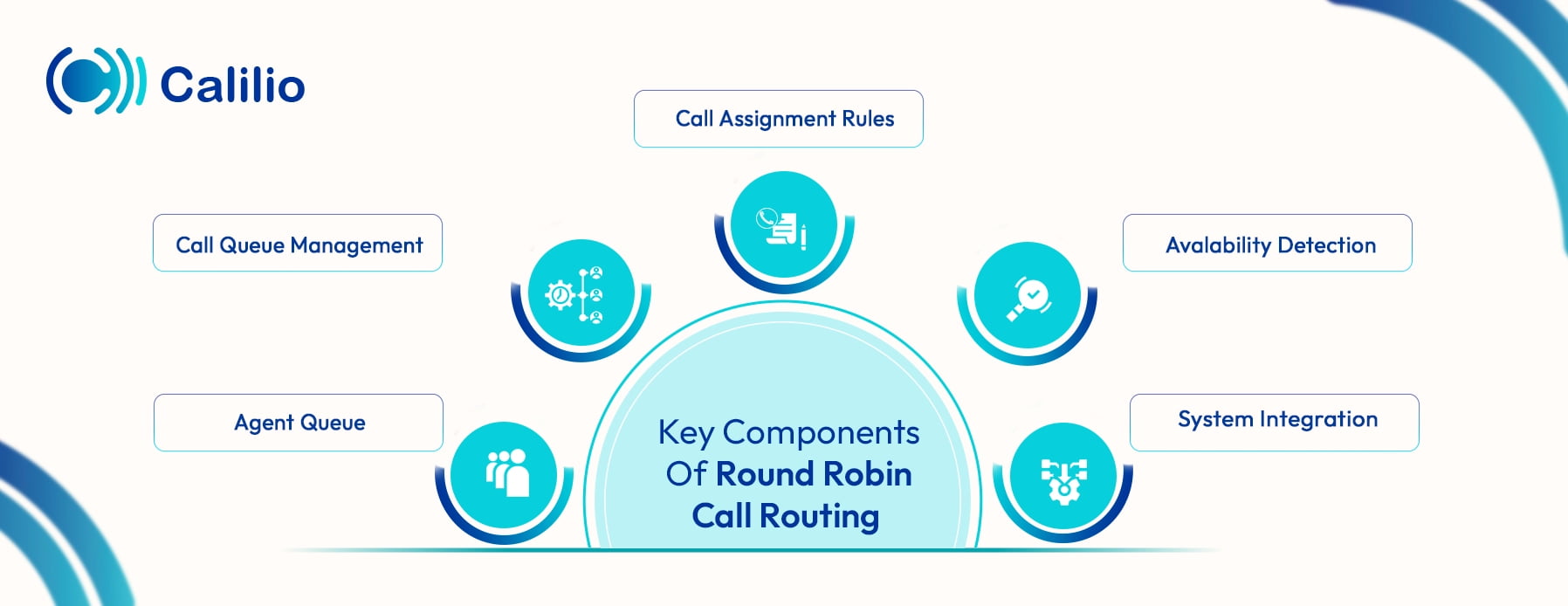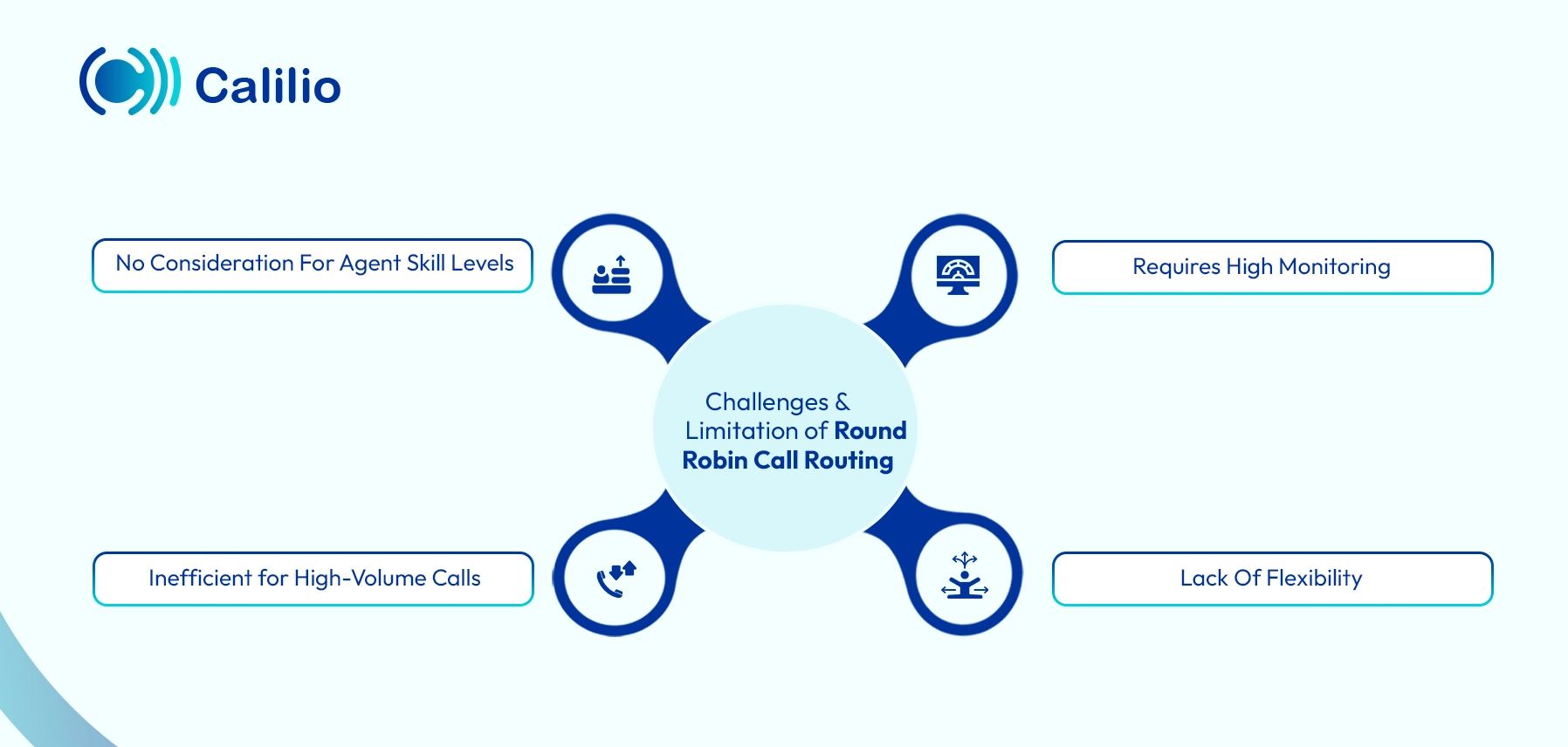Round Robin Call Routing: Benefits, Limitations & Setup Tips

Managing high call volumes while providing excellent customer service is a challenge for any business. But when calls are not distributed properly, some agents end up overloaded, which can affect response times, agent performance, and overall customer experience.
Round robin call routing offers a simple solution for this. It assigns calls to agents one by one in a repeating order, helping maintain a balanced workload across the team. This way, no agent is overwhelmed and no customer is left waiting longer than necessary.
In this blog, we’ll explore what round robin call routing is and how it works in detail. Additionally, we’ll look into its key features, benefits, and limitations.
Keep reading!
Key Highlights:
Round robin call routing distributes incoming calls to agents in a rotating, fixed order to ensure fairness.
Key components of round robin call routing include the agent list, routing rules, system integrations like IVR or ACD, and monitoring tools.
This routing method helps businesses improve agent productivity, reduce wait times, and enhance customer satisfaction.
To effectively implement round robin call routing, businesses must train agents, review call logs, and analyze agent performance regularly.
What is Round Robin Call Routing?
Round robin call routing is a call management method for distributing incoming calls evenly to agents in a fixed, rotating order. Unlike other call routing that prioritizes speed or skills, round robin focuses on promoting fairness by ensuring every agent gets an equal share of calls. This approach is also known as rotational call distribution or equal call assignment.
Many teams integrate round robin routing with Automatic Call Distributors (ACD) or Interactive Voice Response (IVR) to handle high call volumes smoothly and systematically. This method helps businesses maintain service quality while boosting agent productivity and morale.
How Does Round Robin Call Routing Work?
Round robin call routing works by sending each incoming call to the next available agent in a set order. The system assigns the first call to the first available agent, the second call to the next agent on the line, and so on. Once all agents have received a call, the system loops back to the top of the list and continues the cycle.
Here’s a breakdown of the round robin call routing working mechanism:
- Incoming Call: A customer dials your business number, and the call enters the queue.
- Assign the First Call: The system assigns the call to the first available agent in the predefined list.
- Route the Next Calls in Sequence: Each new call is assigned to the next available agent in line.
- Repeat the Cycle: Once all agents have received a call, the system restarts from the top of the list.
Note: If an agent is busy, offline, or already on a call, the system skips them and routes the call to the next available person.
For example: If you have three agents, Agent A, B, and C, when the first call comes in, it’s routed to Agent A. The next call goes to B, followed by the third call going to C. Once all agents have received a call, the cycle repeats: the fourth call goes back to A. If Agent B is unavailable when the next call arrives, the system skips them and routes the call to Agent C.
What are the Key Components of Round Robin Call Routing?
The key elements of round robin call routing include agent queues, call assignment rules, availability detection, and system integration. These components ensure calls are assigned fairly, the system remains flexible, and the customer experience stays consistent.

- Agent Queue: A predefined list of agents who will receive calls in a rotating order. It must be kept up to date to reflect agent availability.
- Call Queue Management: Proper call queue settings help manage high call volume and maintain order during peak hours.
- Call Assignment Rules: These define how calls are routed—whether in strict rotation or with flexibility to skip unavailable agents.
- Availability Detection: The system needs to automatically detect when an agent is busy, offline, or already on a call to prevent delay while assigning calls.
- System Integration: Integrating ACD (Automatic Call Distributor), IVR (Interactive Voice Response), or CRM systems streamlines operations and improves tracking.
What are the Benefits of Round Robin Call Routing?
Round robin calling benefits businesses by balancing agents' workloads and reducing wait times to enhance customer satisfaction. It helps to manage the resources better and address customer inquiries quickly.
1. Balanced Workload
Round robin distributes calls evenly among agents, ensuring no one is overloaded while others are underutilised. This balance leads to a more manageable and efficient workflow for the entire team.
2. Faster Response Times
Calls are immediately sent to the next available agent, helping to reduce average wait times. As a result, your team responds faster, handling calls with greater speed and accuracy.
3. Increased Productivity
Round-robin call routing ensures that all available agents are consistently engaged, preventing idle time. By keeping the team active, it increases overall productivity and maximizes efficiency.
4. Better Resource Management
With a balanced distribution of calls, businesses can manage resources more effectively. No agent is overburdened, and the workflow is optimized across the team, ensuring that all resources are used efficiently.
5. Improved Customer Experience
When agents handle a manageable number of calls, they can give more attention to each client, resulting in higher customer satisfaction. This leads to better customer experiences and encourages loyalty.
Handle A High Volume of Calls By Properly Distributing Them To Your Agents!
Challenges & Limitations of Round Robin Call Routing
Round robin call routing lacks consideration for agent skills, may cause delays during high call volumes, and requires ongoing monitoring to function effectively. While the system distributes calls fairly, it may not be the most efficient option for a business with high call volume or a team with varying skill levels.

1. No Consideration for Agent Skill Levels
Round robin routing assigns calls in a set order, regardless of an agent's skill or expertise. As a result, a less experienced agent may end up handling a complex call, which could delay resolution.
2. Inefficient for High-Volume Calls
If your business receives a lot of calls, round robin routing might cause delays. The system simply sends calls to the next available agent, which can lead to longer wait times if many agents are busy.
3. Lack of Flexibility
Round robin routing might not be ideal for priority calls or situations that require specific expertise. It only follows a simple order, without considering call urgency or specific customer needs.
4. Requires High Monitoring
The system needs to be regularly monitored to ensure that calls are distributed evenly and efficiently. If the list of agents or their availability changes, the system requires thorough adjustment.
Top Tips & Best Practices for Implementing Round Robin Call Routing
For successful round robin call routing, establish clear guidelines, train agents properly, and consistently monitor call distribution. Additionally, enhance efficiency by combining it with tools like IVR routing and regularly testing the system for optimization.
I. Set Clear Call Handling Guidelines
Define how long agents should be on a call and what happens if they don’t answer. Setting expectations for response times helps ensure calls are handled quickly and efficiently.
II. Train Your Agents
Ensure that all agents are familiar with the round robin system and know how to handle inbound calls efficiently. A well-trained team can quickly address customer needs and reduce call handling time.
III. Track Call Distribution
Regularly review how calls are distributed to ensure that the system is working as intended. If certain agents are still receiving more calls than others, adjust the list or routing rules accordingly.
IV. Combine with Other Routing Methods
For businesses with specialized teams or high call volumes, combine round robin routing with other routing methods. You can use skills-based or IVR-based routing alongside round robin to further improve response times and efficiency.
V. Ensure Equal Workload Distribution
Make sure your agent list is balanced. Regularly update the system as your team grows to maintain an even distribution of calls.
VI. Test and Optimize the System
After implementing round robin routing, test the system regularly to identify any issues or delays. Make adjustments as necessary to ensure it continues to meet your business’s needs.
Conclusion
Round robin call routing is a simple and effective way to evenly distribute calls across your team. It helps improve efficiency, reduce agent burnout, and ensure an even work distribution. While it’s not perfect for every situation, it works well in many businesses looking for fair and efficient call handling.
Your Phone System Just Got Cheaper
Virtual numbers from just $2/month
Call rates starting as low as $0.016/min
The most cost-effective VoIP phone system for businesses
Powered by advanced AI telephony features
Compare low-cost business phone systems
Frequently Asked Questions
How do I ensure fair call distribution using round robin routing?
To ensure fair call distribution using round robin call routing, regularly update agent availability, monitor call logs, and adjust routing rules as your team scales.
Can round robin call routing be used with other call routing methods?
Can round robin calling handle multiple locations or departments?
Why is it called round robin?

Still have questions?
Can’t find the answer you’re looking for? Please chat with our friendly team.
Stay in the loop
Get the latest call insights, trends, and updates delivered straight to your inbox.
By subscribing, you agree to receive updates from Calilio.
You can unsubscribe anytime.
Phone numbers
Get International Phone Numbers
Singapore
|Australia
|New Zealand